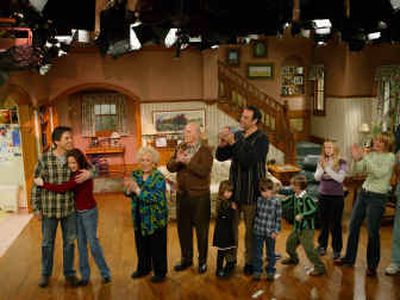Ray calls it a day

Ray Romano has done the math – or so he figures.
“You take the ‘Seinfeld’ finale and you subtract the ‘Friends’ finale and that’s our finale,” he says of the audience for Monday night’s 210th and last episode of “Everybody Loves Raymond.”
The May 14, 1998, “Seinfeld” closer (76.3 million viewers) minus last May’s “Friends” finish (51.1 million) would equal 25.2 million viewers for CBS’ farewell to its longest-running sitcom since “Murphy Brown.”
It’s typical for Romano and the show’s co-creator, Phil Rosenthal, to downplay “Raymond’s” significance in a self-deprecating manner.
“It wasn’t the buzz show. It wasn’t the water cooler show because it wasn’t sexy and flashy and young and all that,” Romano says.
“Raymond” has won 12 Emmy Awards, however, including the grand prize for best comedy series two seasons ago.
And it’s been dependably funny year-in, year-out until reaching the end of the road as the only member of its sitcom species to rank among prime time’s Top 10 shows.
Just once before – in the “Dallas”/”Dynasty”-paced 1983-84 season – has comedy come up this short. CBS’ “Kate & Allie” was the lone intentionally funny member of prime time’s elite 10 in the season before NBC’s “The Cosby Show” almost single-handedly reinvigorated the genre.
“Do I think this is the end of sitcoms? I say yes. In fact I think it’s going to be the end of laughing anywhere,” Rosenthal says. “And after that, smiling will soon go, too.
“But no, it’s all cyclical. There will be another comedy hit that comes along. And as soon as there is one, everyone will say, ‘Oh look, comedy is back.’ So I’m not worried about it.”
Still, only one other comedy series – CBS’ “Two and a Half Men” – looms large on the immediate horizon. The Charlie Sheen-led sitcom is expected to move up a half-hour to “Raymond’s” 9 p.m. Monday slot next fall after following in its wake and placing 11th this season.
After that it’s a long drop to the next highest-rated sitcom, NBC’s 40th-place “Joey.”
Romano and Rosenthal say they’re quitting in the vicinity of the top because there’s nothing left in the tank. They managed just 16 new episodes this season, well short of the standard order of 24.
“We are bone-dry,” Rosenthal says. “God forbid we have ideas beyond this. We’ll have to save them for the 20-year reunion.”
Romano jokes that a reunion show will be filmed this month and then shelved for 20 years so that fans can marvel, “Boy, those people look fantastic.”
The half-hour finale was filmed in late January after being delayed a week by co-star Patricia Heaton’s laryngitis.
“There were tears the whole two weeks that it took,” Romano says. “At the final episode, everyone was in some kind of shock almost. And then at the curtain call, it got emotional for a lot of people. My own (real-life) family got very emotional. That kind of surprised me and caught me off guard.”
“My accountant was crying,” Rosenthal says.
While they’re tight-lipped about the details, don’t expect any dramatic developments Monday night.
“Every week it’s just a new episode in our life,” Romano says. “But there’s a pressure to have a good episode and for it to have some emotional resonance, a little bit more than normal without going too over the top with life-changing moments, which we’re not going to do.”
Initially part of CBS’ Friday night lineup, “Raymond” premiered on Sept. 13, 1996, opposite competition from ABC’s “Sabrina, the Teenage Witch,” NBC’s “Unsolved Mysteries” and Fox’s “Sliders.”
Romano’s character, Ray Barone, had a best pal named Leo, who dropped in for one scene before the character was dropped.
The opening premise: Wife Debra (Heaton) yearned to celebrate her latest birthday without Ray’s officious next-door parents, Frank and Marie (Peter Boyle, Doris Roberts), or his long-faced brother, Robert (Brad Garrett before he later shed 50-some pounds).
She was doomed to disappointment, of course. Meanwhile, Marie forced Raymond to take back his earlier gift to her – enrollment in a fruit-of-the-month club. Otherwise she’d soon have “fruit all over the house!”
Romano longed to take back the title of the show, too. He’s never liked “Everybody Loves Raymond” and still doesn’t.
“I still wish we could go back in time and change it,” he says. But his suggestions – “That Raymond Guy,” “Raymond’s Tree,” “Just Raymond” and “Um, Raymond” – didn’t fly with the CBS brass or in research testing.
“I wish we could have called it ‘Everybody Can Take or Leave Raymond,’ ” Rosenthal says.
Actually, like much of the show, the title came from Romano’s own life. He and his family lived near his parents, and his older brother was a police officer who often muttered darkly that, while he faced criminals and bullets, “everybody loves Raymond.”
When actress Monica Horan, Rosenthal’s real-life wife, joined the cast as Robert’s future spouse, Amy, even her family became grist for the mill.
“It’s the happy, or unhappy, marriage of our families. Ninety percent of what you see on the show happened to me or Ray or one of the other writers,” Rosenthal says.
Before they joined forces, Rosenthal had produced a string of failed sitcoms while Romano delivered futons for his friend’s company. Customers included Robert De Niro, Cher, Judd Hirsch and “a couple of Mets players,” Romano recalls.
He graduated to a salary of $1.8 million per episode for the final season of “Raymond,” making him the highest-paid comedy star in TV history.
It’s ample compensation for never being considered the coolest comedy on the block but rather just “a show that adults would want to watch,” in Romano’s view.
Fans wanting more can savor “Raymond” in reruns and DVD sets or buy “Everybody Loves Raymond: Our Family Album” (Pocket, 2004), co-written by Romano and Rosenthal. It’s rich in pictures, insights and other evidence of why the show prospered.
They’ve indeed left much to love.